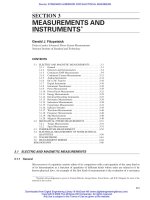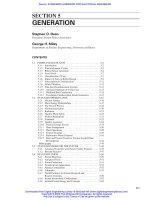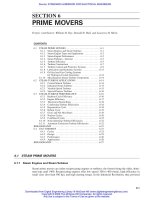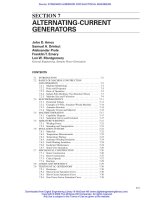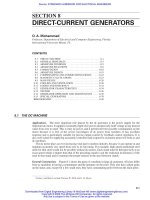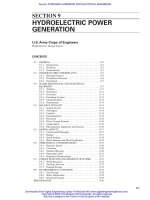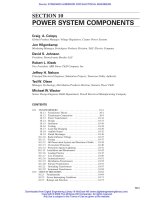handbook for process plant project engineers
Bạn đang xem bản rút gọn của tài liệu. Xem và tải ngay bản đầy đủ của tài liệu tại đây (3.35 MB, 344 trang )
This page intentionally left blank
iContents
Handbook for Process Plant
Project Engineers
by
Peter Watermeyer
Professional Engineering Publishing Limited
London and Bury St Edmunds, UK
ii Contents
First published 2002
This publication is copyright under the Berne Convention and the
International Copyright Convention. All rights reserved. Apart from any fair
dealing for the purpose of private study, research, criticism, or review, as
permitted under the Copyright Designs and Patents Act 1988, no part may be
reproduced, stored in a retrieval system, or transmitted in any form or by any
means, electronic, electrical, chemical, mechanical, photocopying, recording
or otherwise, without the prior permission of the copyright owners.
Unlicensed multiple copying of this publication is illegal. Inquiries should be
addressed to: The Publishing Editor, Professional Engineering Publishing
Limited, Northgate Avenue, Bury St Edmunds, Suffolk, IP32 6BW, UK.
© P Watermeyer
ISBN 1 86058 370 9
A CIP catalogue record for this book is available from the British Library.
The publishers are not responsible for any statement made in this
publication. Data, discussion, and conclusions developed by the Author
are for information only and are not intended for use without
independent substantiating investigation on the part of the potential
users. Opinions expressed are those of the Author and are not necessarily
those of the Institution of Mechanical Engineers or its publishers.
Printed by Cromwell Press, Trowbridge, Wiltshire, UK
This page intentionally left blank
iiiContents
Foreword ix
Acknowledgements x
Chapter 1 Introduction 1
1.1 What’s so special about process plant projects? 1
1.2 The structure and components of this book 3
1.3 Methodology of presentation 5
1.4 Getting it right 7
First Cycle – A Process Plant and a Project
Chapter 2 A Process Plant 13
2.1 Basic process design elements 13
2.2 The processed materials and the process 18
2.3 The process design/detail design interface 20
Chapter 3 A Project and its Management: A Brief Overview 23
3.1 The project 23
3.2 Starting the project 25
3.3 Managing the project 27
Chapter 4 The Engineering Work and Its Management 31
4.1 Planning the engineering work 31
4.2 Doing the engineering work 40
4.3 Managing schedule, cost, and quality 41
4.4 Co-ordinating engineering work 44
4.5 Management of engineering resources 46
Second Cycle – Environment
Chapter 5 The Project’s Industrial Environment 51
5.1 The industry and the client 51
5.2 The client and the project management 55
5.3 The process plant project industry:
the ‘indirect cost’ of a plant 56
Chapter 6 The Commercial Environment 59
6.1 Principles of procurement and contract 59
Chapter 7 The Contracting Environment 65
7.1 Ways of building a plant 65
7.2 The engineering contractor 70
7.3 The project engineer 72
7.4 Conclusion 75
Contents
iv Contents
Chapter 8 The Economic Environment 77
8.1 Plant profitability 77
8.2 Lifecycle considerations and ‘trade-off’ studies 78
8.3 The real world of costs and values 82
8.4 Project engineering and management work 83
Third Cycle – Conceptual Development
Chapter 9 Studies and Proposals 91
9.1 Feasibility studies 91
9.2 Proposals 94
9.3 Estimating project costs 94
9.4 Risk 97
9.5 Accuracy 99
9.6 Contingency 101
Chapter 10 Plant Layout and Modelling 105
10.1 Layout 105
10.2 Design presentation and modelling 112
Chapter 11 Value Engineering and Plant Optimization 117
11.1 Value engineering 118
11.2 Plant optimization models 120
Chapter 12 Hazards, Loss, and Safety 123
12.1 Hazard identification 124
12.2 Designing for safety 127
12.3 Commissioning 131
12.4 Plant modifications 132
Fourth Cycle – Engineering Development and Detail
Chapter 13 Specification, Selection, and Purchase 135
13.1 Procurement 135
13.2 Specification 138
13.2.1 Specification as a document for bidding 138
13.2.2 Specification as a reference for work performance 141
13.3 The selection of equipment 141
13.4 Technical appraisal of equipment bids 143
13.5 Inspection and quality control 145
13.6 Planning inspection work 148
13.7 Expediting 150
Chapter 14 Fluid Transport 153
14.1 A brief note on liquid-pumping systems design 153
14.2 Gases 162
vContents
14.3 Piping engineering and its management 167
14.4 Some concluding comments on piping layout for
pumps and compressors 170
Chapter 15 Bulk Solids Transport 173
15.1 Bulk solids flow 173
15.2 Conveyors 175
15.3 Feeders 181
15.4 Safety and environmental health 183
Chapter 16 Slurries and Two-Phase Transport 185
16.1 Slurry transport 185
16.2 Piping design 188
16.3 Tanks and agitation 189
16.4 Pneumatic conveying 191
16.5 Pipework reactions 192
Chapter 17 Hydraulic Design and Plant Drainage 195
17.1 Hydraulic design 195
17.2 Plant drainage 201
Chapter 18 Observations on Multi-Discipline Engineering 203
18.1 Structural design considerations 203
18.2 Plant and equipment loads 205
18.3 Civil engineering 207
18.4 Electrical engineering 209
18.5 Instrumentation and control 212
Chapter 19 Detail Design and Drafting 217
19.1 Structures 218
19.2 Piping 221
19.3 Vessels 227
19.4 Chutes, bins, and hoppers 229
19.5 Civil design 230
19.6 Instrumentation and control 233
19.7 Electrical design 236
19.8 Other technical specialities and consultants 238
19.9 Overview of the design process 239
19.10 General arrangement drawings and models 240
Chapter 20 Traditional Documentation Control 243
Fifth Cycle – More on Management
Chapter 21 The Organization of Work 249
21.1 Packaging work 249
vi Contents
21.2 Procedures 254
Chapter 22 Construction 257
22.1 Survey and setout 258
22.2 Site management 258
22.3 Technical information for construction 259
22.4 Site materials management 260
22.5 Heavy lifts 261
22.6 The ‘site and office’ relationship 262
Chapter 23 Construction Contracts 265
23.1 Structuring contracts 265
23.2 Structuring payment to contractors 269
23.3 Claims 270
Chapter 24 Commissioning 273
24.1 Safety during commissioning 276
Chapter 25 Communication 277
Chapter 26 Change and Chaos 281
26.1 Change 281
26.2 Chaos 283
Chapter 27 Fast-Track Projects 289
27.1 Case study A: Fabulous Fertilizers’ new plant 292
27.2 Case study B: Magnificent Metals’ new gold plant 293
Chapter 28 Advanced Information Management Systems 297
Final Cycle – Strategies for Success
Chapter 29 Project Strategy Development 305
29.1 Is the target correct? 307
29.2 How do we get there? 308
29.3 What are the major problems? 309
Chapter 30 Key Issues Summary 311
30.1 Key project or study issues at the conceptual stage 311
30.2 Key issues at the project execution phase 311
30.3 Key issues for the conduct of the individual
engineer or engineering business unit 313
30.4 General business issues 313
Appendix 1 Jargon 315
A1.1 Definition of design parameters 316
viiContents
Appendix 2 Design Criteria Checklist 317
A2.1 Plant performance 319
A2.2 Plant site 319
A2.3 The process 319
A2.4 Basic plant design features 320
A2.5 Design features for equipment (mechanical,
instrumentation, and electrical) 320
A2.6 Design methodology and standardization 320
A2.7 Design verification and approval plan 321
A2.8 Design and plant documentation for client 321
Index 323
This page intentionally left blank
viii Contents
How Did That Happen –
Engineering Safety and Reliability
IMechE Engineers’ Data Book
(Second Edition)
Improving Maintainability and
Reliability through Design
A Practical Guide to Engineering
Failure Investigation
Process Machinery – Safety and
Reliability
Plant Monitoring and Maintenance
Routines (IMechE Seminar)
W Wong
C Matthews
G Thompson
C Matthews
W Wong (Ed.)
1 86058 359 8
1 86058 248 6
1 86058 135 8
1 86058 086 6
1 86058 046 7
1 86058 087 4
Related Titles
For the full range of titles published by
Professional Engineering Publishing contact:
Marketing Department
Professional Engineering Publishing Limited
Northgate Avenue
Bury St Edmunds
Suffolk
IP32 6BW
UK
Tel: +44 (0)1284 724384
Fax: +44 (0)1284 718692
Website: www.pepublishing.com
ixContents
Foreword
Project engineering comprises the orchestrated integration of all
engineering disciplines to achieve a commercially defined project
objective. The quality and effectiveness of project engineering are key
components of process plant design and construction, a business which
invariably requires complex multi-disciplinary design input and focused
customer and commercial awareness.
Courses in the individual disciplines such as civil, mechanical, and
chemical engineering are offered by many universities and other
institutions. By contrast, the art of project engineering is usually
acquired the hard way, through practical involvement in project
execution. Unfortunately, much of the necessary experience is too often
painfully gained by learning from expensive mistakes.
Peter Watermeyer has a keen interest in analysing the causes of
success, failure, mediocrity, and excellence in project execution. He sees
these as a function of not only the performance and management of the
engineering work, but also of the way that work and project teams are
structured and orientated in relationship to their whole environment.
Peter has a wealth of practical experience in the industry. He spent 15
years in the power, hydrocarbons, and process machinery industries
before joining Bateman, where he has spent over 20 years in the
engineering and management of process plant projects, mainly in the
international mining and petroleum industries.
This book, which is based on the knowledge, skill, and diverse
experience of a master of the art will, I believe, prove to be of great value
in guiding aspiring and less experienced project engineers towards
achieving full professional competence in this challenging arena.
Dr John P Herselman, DrIng, Dipl-Ing, BSc (Chem Eng), FIOD
Executive Chairman, Bateman BV
This page intentionally left blank
xiContents
Acknowledgements
The illustrations in this book are by Natalie Watermeyer and the
photographs and drawings are reproduced with permission from
Bateman Projects Ltd.
I am grateful to Phillip Ashworth, for his review and guidance on
the revision to the original text. I would also like to thank the editorial
staff of Professional Engineering Publishing, and in particular the
commissioning editor Sheril Leich and the co-ordinating editor Mandy
Kingsmill, for their very professional work.
This page intentionally left blank
Introduction 1
Chapter 1
Introduction
This book is intended to assist people who design and build process
plant, and people who participate in multi-disciplinary engineering
projects in general. The book is aimed in particular at the project engineer,
or team of lead engineers, who inevitably hold such projects together,
being at the heart of the information generation system which shapes
and guides the project.
The design and construction of process plant covers an exceedingly
wide field of performance and knowledge. Considering engineering
topics alone, those which impact process plant design include the work
of very many specialist technical branches. But this is only part of what
has to be considered in successful project engineering. Interwoven with
the engineering and design of the plant are many commercial, construc-
tional, financial, and social considerations. It may be satisfying for the
technical purist to focus exclusively on engineering issues, but the
engineer who does so is likely either to be limited to a subordinate role,
or to be part of an unsuccessful enterprise – engineering considered on
its own becomes an academic pastime.
The content of the book is therefore intended to address that mixed
bag of technical, commercial, managerial, and behavioural issues which
constitute the actual job content of the practising engineer, and are
peculiar to this industry.
1.1 What’s so special about process plant projects?
In some cases – nothing! A relatively small and simple project can
usually be executed by a single experienced engineer with a minimum of
fuss, and without complex procedures or strategy. This is especially the
2 Handbook for Process Plant Project Engineers
case for plants which are very similar to existing units. Within the
following text may be found some helpful aspects of technical advice
for such projects, but the work must not be over-complicated. Any
higher-level issues of strategy and management are best addressed
(if at all) at the level of organization which encompasses the small
project, for example the corporation which requires the project, or a
contracting organization which delivers such projects. The following
text is primarily addressed at relatively large and complex projects,
requiring the interaction of a number of skills – technical, commercial,
and constructional.
Compared to the general field of engineering design and construction,
the main differentiating factors which have to be addressed in these
projects are the following.
• The unique design of each plant is the inevitable consequence of the
need to optimize each application to its unique circumstances of
feedstock, product, capacity, and environment.
• Plants are built around hundreds of items of proprietary processing
equipment. The plant design must interface exactly with the
operational characteristics and dimensions of these individual items.
The interface information can only be finalized when the commercial
agreements with equipment suppliers have been concluded.
1
• Both the plant design and its construction employ many types of
specialist, who must interact at thousands of interfaces (and often
work simultaneously in the same plant space envelope) to produce a
co-ordinated product.
• Plant operation can be hazardous. The elimination or control of
hazards, and the establishment of safe operating practices, are
prerequisites of plant operation, requiring priority attention during
plant design. Environmental impact is also invariably an issue.
• Technology development is rapid and continuous. This greatly
impacts on the uniqueness of process and plant design (the first item
above), but also often impacts on project execution – there is often a
desire to accommodate changes while design and construction are in
progress.
1
This is at least the common practice in free-market economies. In communist countries,
it was (and still is) often the practice to ‘centralize’ equipment designs, so that the plant
designer can simply choose a completely detail-designed equipment item from a
catalogue. This simplifies the plant designer’s job,but often at great cost at the construction
stage, when there is no commitment from a supplier to match the project programme or
budget. Also, it shifts responsibility for ‘fitness for purpose’ of the item.
Introduction 3
• The project schedule cannot be generated in any mechanistic
fashion. Invariably, the critical path can be shortened almost ad
infinitum by taking various shortcuts (in other words, by changing
the schedule logic – not just by employing more resources or working
faster). These possible shortcuts come at a cost or risk, which must
be balanced against the benefits.
• The nature of the industry served by process plant usually puts a
high premium on early plant completion and operation.
• The plant has to be constructed on site, to suit its site, wherever that
may be.
The degree to which these and other features are present, together with
the more obvious comparisons of size, cost, and complexity, dictate the
intensity of the challenge to the project team. All of these features have
to be addressed during the plant engineering and its follow-up.
1.2 The structure and components of this book
The main objective of this book is to give guidance on how the project
engineer’s work is carried out in practice. We have therefore to consider
how all items of information interact, and how they are brought
together in each practical situation. This is a distinctly different objective
from that of a technical reference book, such as Perry’s Chemical
Engineer’s Handbook. This is a recommended reference for any engineer
in the process plant field, and contains a wealth of information, but it is
targeted and indexed by technical subject. We need a different structure
here, in which the sequence of information is important and is project-
related. It is convenient to address the structure at four levels.
In defining these levels, an immediate pitfall can be identified and
should be avoided. In organizational and management terminology,
invariably there is a high and a low level. This should not be confused
with relative importance – all of the organization components are
important. Within each level, there are likely to be relatively less and
more important functions for a given project, but a project can be
jeopardized just as easily by poor detail design as by poor management.
Subject to this qualification, the base tier, level one, consists of the
activities of detailed design, procurement of parts, delivery to site,
construction, and commissioning, and all of these will be addressed.
Inevitably in an integrating text such as this, most topics have to be
discussed at a relatively superficial level, concentrating on those facets
which are more essential, either to the interactions with the whole, or
because of relatively high individual impact to the project and the plant.
4 Handbook for Process Plant Project Engineers
At the level above, level two, reside the technical focus and project
control, which give direction to all the detailed work. The centrepiece
of this is the process technology package. The technological content
of such packages is outside the scope of this book – it is the domain
of many experts and organizations, embracing diverse fields of technical
specialization such as catalytic conversion and hydro-metallurgy, and
niches within these fields which yet consume entire careers. We will
rather (and briefly) address the generalized make-up of such packages,
of how they relate to the plant to be built and to the project around
them. In addition, we will discuss the system of engineering and infor-
mation management (also at level two), which governs the performance
of level one activities.
Not particularly addressed at level two, because of the focus of this
book, are the methodologies of managing procurement, logistics,
contracts, finance, and construction. The reader with greater project
management aspirations is advised to refer to specialized texts on these
subjects. We will, however, discuss the principal interfaces with
engineering work and its management.
At level three, we have a management system for the entire project.
This is conventionally broken down into three or four components,
namely management of scope, quality, cost, and schedule. (Scope and
quality may be regarded as a single issue, a practice not recommended
by the author.) Health and safety considerations may properly also be
managed at this overview level, and must be included in any such text.
At level four, there is only one item, project strategy. This has to
ensure that the project is correctly conceived (technically, commercially,
economically, socially) and embodies the skeleton of the over-arching
plan which will ensure that the goods are delivered in the optimum
fashion. Inevitably the strategy must deal with the issues of relationship
management between the principal stakeholders, for example the plant
owner (usually, a complexity of people and interests) and contractors,
including possibly a single lump sum or managing contractor, and a
variety of sub-contractors and suppliers. The strategies are bound to be
different for each stakeholder, reflecting the basic question of ‘What do
I want out of this project?’
There is a significant body of professional opinion that such con-
siderations of strategy are not appropriate in the context of what should
be the technical field of engineering. (In the author’s experience, there
are also several senior executives who are relatively ignorant of the links
between engineering and strategy, and feel quite threatened!) There are
those who argue that management of large projects, whether or not
Introduction 5
centred on multi-disciplinary engineering, is primarily a matter of
project management practice, and can be quite separately treated as
such. Both of these views can be dangerous. From level one to level
four, there are common threads, mainly of engineering information and
its development, which have to be taken into account when making
management decisions. The understanding and maintenance of these
threads, many of whose origins are at the detail level, are the essence of
the discipline of project engineering.
The interaction between project strategy and engineering execution
operates in two directions. It will be seen within this text that the adoption
of project strategy – including for instance the structure of the relationship
between client and contractor – has major implications for the way in
which engineering is optimally conducted. In reverse, the best project
strategy (for each party) is likely to depend on some of the engineering
realities.
The technical content of this book posed a particular challenge of
selection and condensation. Nearly every topic could be expanded into
several volumes, and must in practice be covered by specialist engineers
with far more knowledge than is presented. The intentions behind the
information presented are twofold. Firstly, to include just sufficient
information for a generalist (the project engineer) to manage the specialists,
or to assist the specialists to co-ordinate with each other and find the
best compromises. Secondly, to include some of the author’s own
experience (spanning some 30 years) of simple but important items
which do not seem to be conveniently presented in textbooks or standards,
but which can prove important and costly.
1.3 Methodology of presentation
Project engineers have traditionally learnt much of their job-knowledge
by experience. The mainly technical aspects can be taught in isolation as
an academic subject, but even these have to be tempered by experience,
to match theory to application. The behavioural and management
aspects of job performance are even more dependent on the acquisition
of relevant experience. Through a few project cycles in relatively junior
roles, engineers have gradually broadened their skills and their under-
standing of what is going on, inside and outside of the project team, and
become aware of the consequences of design decisions and of the way
actions and events interact. They have learned to recognize problems,
and learned some standard solutions and how to choose the best
6 Handbook for Process Plant Project Engineers
solution for the circumstances. They have also absorbed something of
the culture of their industry, and learnt how to behave and influence
others, to make the best of their working relationships. They have
become ready for a leading or management role.
It is our objective here to produce a text which accelerates this process
of learning, and enhances it by trying to transfer some of the author’s own
experience and retrospective analysis of successes and failures. Surely the
process of learning by experience can be accelerated, and some of the pain
reduced.
A limitation of trying to synthesize such a learning process is that a
balanced progression must be achieved, in which all the interacting
subjects are advanced more or less in parallel. It is no good giving a
dissertation on the merits and techniques of compressing project schedules
unless the more normal schedule practice and its logic are understood. It
is equally fruitless (and boring, and unlikely to be absorbed) to discuss the
finer points of project management, let alone strategy development, until
it is understood what are the work components (and their characteristics)
which have to be managed and optimized.
The book has therefore been set out into six cycles, each targeted at a
different and progressive stage of development. The first cycle consists of
an overview of a process plant, the process technology package, a very
brief outline of the management of a project to build a plant, and a brief
description of the engineering work and its management. The second
cycle looks at the project environment, in particular some non-engineering
factors which influence the work of the project. The third cycle is about
project initiation and conceptual development. This becomes possible
when the nature of the project and its environment are understood. We
have also chosen to address the subject of hazards and safety at this point.
The fourth cycle addresses plant engineering technical issues, at a more
detailed level, and is the largest component of the book. The fifth cycle is
concerned with project engineering and management issues which need
a particular emphasis in this industry, leading up to a final cycle which
discusses strategy development.
It may be noticed that the two structures, of level and of cyclical develop-
ment, are not strictly parallel, but compare more like a traditional four-
cylinder engine firing cycle of 2-1-3-4. Even this analogy is somewhat
misleading. There is no single direction leading to strategic understanding,
but rather a matrix where every part depends more or less on every other
part, and the strategy requires a knowledge of all the parts. Strategic
performance, without detailed performance, is of no value whatever, and
both continue to evolve and require a continuous learning process.
Introduction 7
Turning to the basics of the format of presentation, in an endeavour
to provide a text that can be useful for on-the-job reference, the general
mechanism employed is the checklist. Wherever possible, the text has
been formatted into bullets, which are intended to provide a structured
approach to the common practical situations, by helping the engineer
both to plan his
2
approach and to check that he is addressing all essential
facets.
1.4 Getting it right
The basic project methodology advocated in this book is to start a
project by looking as widely as possible at the choices presented, evaluate
the full consequences of those choices, and then develop a strategy to
make the best of the opportunities and eliminate the risks. The strategy
is further developed in a structured fashion, leading to detailed plans
and methodologies, which are based on solid experience that has been
proven to give manageably acceptable results.
It all sounds very simple. And yet, so many individual engineers, and
organizations of engineers, fail to produce acceptable results. Individual
intelligent and well-educated engineers fail to rise above mediocrity, and
whole engineering organizations become obsolete and disappear. Others
prosper: some seemingly by sheer luck, by being in the right place at the
right time, but mostly by getting the right balance between having a
good strategy, based on recognition of personal objectives, and the
diligent deployment of sound skills.
There really is not much more to be said about the path to success,
but it is quite easy to comment on the failures. A few main categories
are worth mentioning.
• Bad luck. As real calamities such as political risk or natural disaster
can and should be insured against, this should rather be described as
the occasional, unfortunate consequence of excessive risk. Some
degree of technical risk is inevitable for developing technologies,
without which a technically based enterprise is anyway unlikely to
flourish. The same goes for commercial risk, which is necessary to
seize opportunities. The key is to have a considered risk management
2
Throughout the text, the male gender is intended to include the female. This is done
purely for the purposes of simplification.
8 Handbook for Process Plant Project Engineers
plan, which recognizes and excludes risks whose possible conse-
quences are unacceptable, and balances manageable risk against
reward. This should lead to ample compensation in the long run. In
conclusion, this is an element of strategy.
• Lack of knowledge (job-information, know-how or commercial
practice) or of diligence. The following text should hopefully impart
enough knowledge at least to assess how much additional expertise
and information is required for a given project. No remedy is avail-
able for the second shortcoming.
• Setting of unreasonable targets. The detail of how this sometimes
comes about, and how it can be recognized, will be addressed in the
text – it is really a relationship issue. Occasionally, social or political
factors, or ‘brain-dead’ enterprise directors, spawn projects which
inherently have little or no real economic return – a conclusion which
is hidden by an unreasonable target. Stay clear of these projects!
• Running in reactive mode. Here is an example. A natural resources
company needs a new process unit to enhance its product slate. Its
technical manager (the client) is appointed to oversee the project. He
is a leading expert on the technology application, and Knows What
He Wants, but is not terribly good at communicating it – or listening
for that matter. In due course a project team is assembled under a
project manager, including a process design team and a lead engineer
Fig. 1.1 ‘ a good strategy, based on the recognition of personal
objectives, and the diligent deployment of sound skills’
Introduction 9
for each discipline. A planner is recruited. He loses no time in getting
plans from each discipline, and putting them together into an overall
network. Unfortunately, he does not fully understand the interaction
between disciplines of detailed engineering information, the potential
conflicts, or how they may be resolved. The client dictates that the
project schedule must be 16 months to commissioning, because he
heard that was achieved somewhere else, and the planner duly jockeys
the project schedule around to reflect this. The client also dictates the
project budget. This includes no contingency, because he Knows
What He Wants, and contingencies will only encourage the project
team to believe that error and waste are acceptable.
As time goes on:
– Engineering gets further and further behind schedule, as each
discipline in turn is unable to start or complete jobs because of
the unavailability of information from equipment vendors and
other disciplines.
– Design and procurement decisions are endlessly delayed,
because the client is not offered what he Wants, and expects the
project team simply to make up the delays. They do not.
– Many of the project drawings become full of revisions, holds,
and – inevitably – interface errors, because the wrong revisions
of input information were used, or assumptions were made but
not verified and corrected.
– In the struggle to catch up, quality functions, such as layout
design reviews and equipment and fabrication inspections, are
skimped.
– The project manager loses control of the project – in fact, he
spends most of his time arguing with the client, usually to try to
stop process and layout changes being made. (‘These aren’t
changes’, the client would say. ‘They are corrections of error.
You failed to design what I Wanted.’)
– The construction site degenerates into chaos. The construction
management are unable to handle all the late drawings, design
errors, late deliveries, flawed materials, and acceleration demands.
– Both schedule and budget are grossly overrun, and the
construction contractors make a fortune out of claims, especially
for extended site establishment. And the plant is not What The
Client Wanted.
If none of this seems familiar – you are new to process plant work. But
it is all quite unnecessary.

